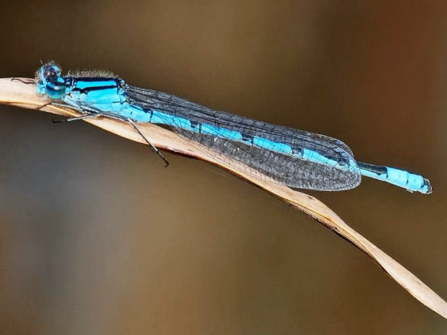
Common blue dragonfly (c) Joe Finlay

Common blue dragonfly (c) Joe Finlay
70% of the recorded sightings came from Durham Wildlife Trust volunteers, and as a result, 2315 records were submitted. This was a big increase over 2020, where there were 1257 recorded sightings. All of those sightings have been collated into the annual report, which can be downloaded from here.
Over the years, 24 species have been spotted, and 21 appear to be established or regular visitors. 19 Odonata species were seen in 2021, (down from 20) and that does not represent a decline as such, just that some of the rarer species need an element of luck and broad geographic surveying for them to be observed. For that, we need more volunteers to go and survey our reserves and areas to the west of the Durham Wildlife Trust region.
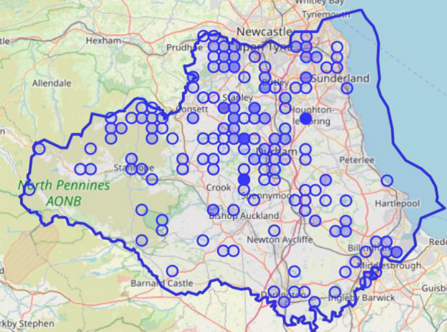
Odonata Sightings 2021 Durham Wildlife Trust Region
The season started at the end April, with the first large red damselfly. This is typically the first to emerge, and by the end of August, there were 183 sightings. The blue damselflies that most people associate with Odonata (blue tailed, azure and common blue) appeared in early May, along with the first dragonfly, a broad bodied chaser on the 13th.
The River Wear and related becks and streams run near a number of Durham Wildlife Trust sites, and provide ideal habitat for the banded demoiselle. They were spotted on 61 occasions at a variety of locations, between 31st May and 5th August, so a short season for them. For the first time in many years, they were also seen at Rainton Meadows, and as they prefer river environments, it is suspected that they bred in nearby boggy land or in culverts between ponds.
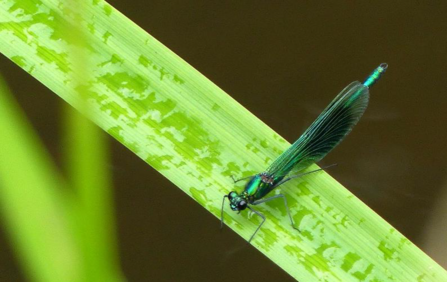
Banded Demoiselle (c) Ian & Elaine Burnell
Two species that were in short supply in 2020, were the golden ringed dragonfly and the brown hawker. 2021 saw them return in good numbers and there were 27 and 74 sightings respectively. The golden ringed appears to prefer the high moorland areas to the west of our region, and as this is often remote and difficult to access, the increase appears to be due to spotters walking there, as opposed to a population increase.
The Durham Wildlife Trust headquarters is at Rainton Meadows, between Sunderland and Durham, and once again it proved to be a dragonfly hotspot, with 15 (down from 16) of the 19 species seen there, often in very large quantities. There were 275 records from Rainton, and the creation of a new wetland area should mean that it continues to grow as the ideal place to go and see Odonata. Sadly, we did not see a small red eyed damselfly at Rainton again this year, but at nearby Brasside Pond, they were in amongst hundreds of damselflies of many species, ovipositing and coupling on the floating weed. Having seen them laying eggs, it is hoped that this very rare species will become resident in our region.
No lesser emperor sightings this year, but an abundance of the larger cousin, the emperor. With 60 sightings, it gave rise to a number of Game of Thrones references about “the rise of the Emperors”. They were seen across the region, and in particular, at Rainton Meadows, where one did an aerial display amongst visitors being trained in dragonfly identification.
Black darters (close up photo below, by Mal Wilkinson), are not common in our region, with Greencroft Nature Reserve being a stronghold, however, they were seen at Burnhope Pond, which added to the ever growing number of species breeding there.
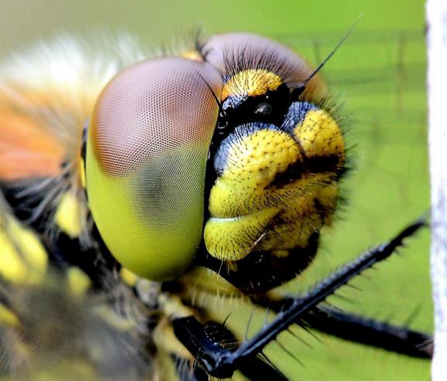
Black darters close up photo (c) Mal Wilkinson
Rainton Meadows, Low Barns, Burnhope Ponds, Malton, Shibdon and Milkwellburn Woods, were the best Durham Wildlife Trust sites to see species such as, broad bodied and four spotted chasers, plus black tailed skimmers, migrant and southern hawkers, (plus all species of damselfly).
In 2021, the BDS published the “The State of Dragonflies Report”, where 50 years of records were analysed. This concluded that a number of species were in decline, including the emerald damselfly, and that appears to be the case in our region too. Emeralds are easily identified when in their adult state due to the bright iridescent colouring of the thorax, and as you can see here in Christopher Bill’s photo, their bright blue eyes.
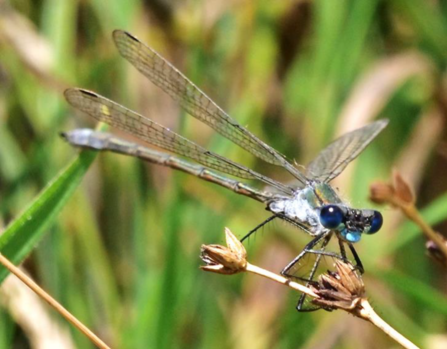
Emerald damselfly (c) Christopher Bill
There are various possible reasons for the decline, one being that they emerge late in the season, and the increasingly long dry summers mean that ponds in which they are living as larvae dry out. Therefore, the emerald might be a victim of climate change, and that is one reason why surveying Odonata each year is so important.
If you would like to assist Durham Wildlife Trust Trustee and County Recorder, Michael Coates, to survey the region, please contact him michaelbds@zohomail.com. Michael will also be running identification walks and talks, look out for details on our events page. To download a copy of the annual dragonfly report click here. For a map showing over 60 dragonfly hotspots in our region click here https://tinyurl.com/2p8z27zn
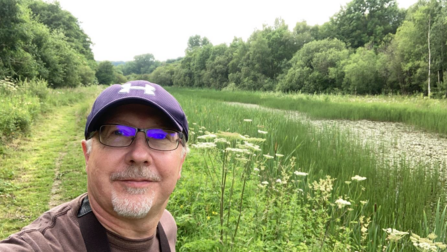
Durham Wildlife Trust Trustee and Dragonfly County Recorder, Michael Coates at Barlow Burn Nature Reserve (a great site for southern hawker dragonflies and many species of damselflies).